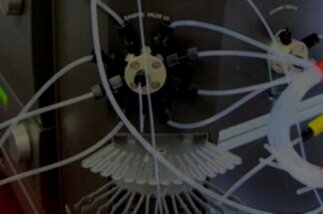
Maintenance & Service for 405™ LS & 405™ TS Microplate Washer Models
You rely on your equipment. Your equipment should rely on ATG.
Your microplate washer is a critical contributor to your lab’s productivity. If you are experiencing technical problems with a BioTek® 405™ LS or 405™ TS, you need to get it fixed and fully operational ASAP. That’s what Analytical Technologies Group is for. Our experienced engineers have intimate knowledge of these and other BioTek® plate washers, and our inventory of in-stock replacement parts enables them to remedy your problem quickly and efficiently.
Over 4,000 labs have relied on ATG to keep them running smoothly. Don’t hesitate to do the same!
Tips for keeping your BioTek® Microplate Washer in good working order:
Ensure to keep the devices clean and the tubing wet.
Make sure that the bottles, solutions, and tubing are clean and do not contain any particles or mold. Solutions that are recycled over several days will grow algae, bacteria, molds, or other undesirable organisms.
Prime the tubing to remove air bubbles before dispensing. Priming the tubing is the most critical factor in assuring optimal performance.
Fill the supply bottles with sufficient fluid. Never run the them without the fluid filter installed (on the end of the tubing inside the supply bottle).
To avoid spilling fluid when refilling bottles or changing reagents, first release the Quick Connector from the bottle cap, use a paper towel to sop up the few drops in the cap. Then, refill the bottle.
Empty the waste bottles and firmly seat the bottles’ caps and quick release connectors. To make sure fluid does not back up into the vacuum pump during operation keep the waste sensor cable installed and the waste detection sensor activated. If fluid collects in the overflow bottle, thoroughly rinse the fluid-level switch and bottle.
Check the external tubing connections for kinks and clogs.
When the washer is equipped with BioTek’s Verify™ Technology (“Q” models), before processing your assay plates, take five minutes to run the Verify routine to ensure the manifold tubes are not clogged.
Put microplanes on the carrier with well A1 in the left rear corner as you face the instrument, and firmly seat the plate in the carrier.
Having technical problems with your BioTek® 405™ LS and 405™ TS?
Fast Response
We provide very prompt responses to customers within one business day.
Fast Turnaround
Our field service engineers are expediently dispatched across North America & Europe to fulfill your service request.
Expert Staff
ATG’s highly trained, highly skilled staff ensure your instruments remain in optimal condition.
Replacement Parts Stocked
To minimize instrument downtime, we stock virtually all parts for the systems in which we specialize.
BioTek® 405™ LS and 405™ TS Models Troubleshooting Tips:
Most common problems can be avoided by daily/periodic cleaning and general maintenance.
If there is a carrier or manifold position error: the manifold or carrier may be obstructed, there may be a motor, sensor, or electrical problem, there may be a misaligned carrier or manifold, or the manifold setting may not match the installed manifold.
If the vacuum pump does not start or shakes when turned on, check whether the pump is not turned on, the vacuum pump accessory cable is not installed correctly, there is too much residual vacuum force for the pump, or there is a blown fuse in the accessory outlet.
For poor or uneven aspiration: there may be insufficient or no vacuum, clogged aspirate tubes on the washer manifold, the microplate aspiration height adjustment may be too high or too low, or there may be a vacuum pump failure.
Should the plate overfill (floods): the dispense height might be too high, the aspirate tubes may have hit the bottom of the trough during Prime or Maintenance, the dispense flow rate might be too low, the cell wash flow rate 1 or 2 is used with 384-well plates, the in-line vacuum filter is plugged, the covers on the waste bottles might be loose, there may be insufficient or no vacuum, or a faulty vacuum, pump.
If fluid is leaking from the manifold: check whether there are defective seals, the surface of the washer is uneven (not level), or the vacuum is too low for the aspirate tubes.
If fluid is leaking from underneath the instrument: check whether there is defective tubing connector or inlet tubing or a leaking valve.
Should there be too much residual left in wells after aspiration, check whether the vacuum filter is clogged, the waste bottle cover is not properly sealed or fittings not properly connected, the manifold is out of the alignment or not moving freely, the Protocol requires optimization, or the aspirate tubes are bent.
For uneven aspiration of the water buffer: there may be no surfactant in the buffer (such as Tween® 20), there may be insufficient vacuum, the Protocol settings might not be optimized, the aspiration tubes might not be properly positioned horizontally in the wells, or the microplate might not be level in the carrier or the strips are not level in the holder.
If it’s unable to dispense fluid: the inlet tube might not be connected properly, the fluid filter, the valve, or the dispense tubes on the washer manifold may be clogged, the system might not be primed, there is no wash or rinse fluid, or there is insufficient suction, clogged tubing, or a faulty valve.
For uneven dispensing of fluid or the wells do not fill: check whether the manifold or tubing is adequately primed, the dispense flow rate is too low, the dispense tubes on the washer manifold are clogged, or the microplate aspiration height adjustment is too high or too low.
Should the aspirate tubes not enter the well correctly: check if the aspirate tube(s) are bent, the microplate is not properly seated or strips are not level, or the horizontal aspirate position is programmed too wide for a movement.

